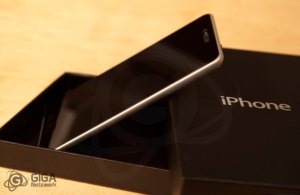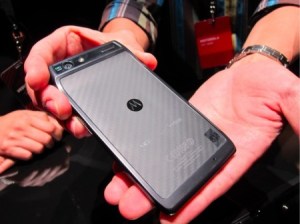It seems like every week a must-have smartphone is either announced or released. It’s becoming increasingly difficult to track which phones are actually worth paying attention to and which will be swiftly thrown into the scrap heap of devices nobody cares about.
So, after a year of smartphone overload, we want to look back and see which devices this year actually mattered. Some will be obvious, others less so. But perhaps by paying special attention to the most relevant devices of 2011, we’ll be able steel ourselves for the avalanche of new models coming in 2012. (Don’t forget that the next Consumer Electronics Show is just weeks away.)
iPhone 5
 Yes, the most talked about phone this year is one that doesn’t even exist yet. Rumors of the iPhone 5 began shortly after the iPhone 4’s release, but throughout 2011 the talk reached fever pitch with speculation of a thinner, larger-screen iPhone. iPhone 5 speculation was so rampant that some fans managed to create a stunning replica of the device, and many expected Apple to announce it in October. Instead, we got the iPhone 4S (more on that below), which initially left hardcore Apple fans disappointed.
Yes, the most talked about phone this year is one that doesn’t even exist yet. Rumors of the iPhone 5 began shortly after the iPhone 4’s release, but throughout 2011 the talk reached fever pitch with speculation of a thinner, larger-screen iPhone. iPhone 5 speculation was so rampant that some fans managed to create a stunning replica of the device, and many expected Apple to announce it in October. Instead, we got the iPhone 4S (more on that below), which initially left hardcore Apple fans disappointed.
But even though iPhone 5 rumors have quietened down, they never truly died off. The sheer amount of early information on the phone hinted that it was indeed something Apple was working on — we likely just got our hopes up a year too early. Speculation was further buoyed by a report from analyst Ashok Kumar, who said that the iPhone 5 was Steve Jobs’ last major project with Apple. Kumar echoed previous rumors, saying the phone will be thin and sport a 4-inch screen, but he added that it will support 4G LTE technology as well.
I wouldn’t be too surprised if all of the rumors proved true come next year.
iPhone 4S
 So instead of the iPhone 5, we got the iPhone 4S. Sure, it looks exactly the same as the iPhone 4, but the introduction of Apple’s virtual assistant Siri is a significant computing milestone that shouldn’t be ignored. As I wrote in my iPhone 4S review:
So instead of the iPhone 5, we got the iPhone 4S. Sure, it looks exactly the same as the iPhone 4, but the introduction of Apple’s virtual assistant Siri is a significant computing milestone that shouldn’t be ignored. As I wrote in my iPhone 4S review:
More than a smarter version of the iPhone’s previous voice command feature, Siri represents the first step towards widespread adoption of consumer artificial intelligence (AI). It’s the beginning of something that will fundamentally change the way we live with our computing devices over the coming years.
The phone also sports Apple’s dual-core A5 processor and an improved 8-megapixel camera, which helped make it competitive against ever-faster Android smartphones. But while the better hardware is nice, the real star of the show is Siri. The iPhone 4S is also the first iPhone to be available on multiple carriers at launch, with Sprint joining Verizon and AT&T.
You’d think that consumers wouldn’t have flocked to the iPhone 4S since it looks exactly the same as last year’s model, but you’d be wrong. Apple managed to sell 4 million iPhone 4S units in its launch weekend alone, and analysts expect the company to sell at least 30 million this quarter. Not bad for a phone stricken with a 3.5-inch screen in an era of 4.3-inch behemoths.
Galaxy Nexus
Google’s Nexus line typically sets the stage for the next year in high-end Android devices, and Samsung’s Galaxy Nexus doesn’t disappoint. With a 4.65-inch screen, the Galaxy Nexus inches into tablet territory. It certainly makes a striking comparison to the iPhone 4S. Spec-wise, the phone has pretty much everything you’d want in a dream device (although its camera still lags behind the iPhone 4S’ more sophisticated 8-megapixel shooter).
The Galaxy Nexus is also notable for being the first Android 4.0 device. With its latest mobile OS, Google is finally focusing on making users love their Android phones as much as iPhone users fawn over their devices. Android 4.0 sports a cleaner and friendlier interface than previous iterations, and according to Google’s mobile design guru Mattias Duarte, it’s just the beginning.
Indeed, there’s a level of polish that Android has lacked since its inception, and I’m hoping that Duarte’s new design focus will bring it to the level of iOS and Windows Phone. Android has always been great for techies, but for average users it can often be an exercise in frustration.
Droid Razr
 Did you miss the Razr brand? Me neither, but Motorola certainly did. As I said when the phone was first announced, it’s an unholy union between Motorola’s former and current top phone brands. The Droid Razr aims to be a reminder of what made the original Razr so cool (Look ma! It’s thin!) while also cementing Motorola’s role as a powerhouse Android manufacturer.
Did you miss the Razr brand? Me neither, but Motorola certainly did. As I said when the phone was first announced, it’s an unholy union between Motorola’s former and current top phone brands. The Droid Razr aims to be a reminder of what made the original Razr so cool (Look ma! It’s thin!) while also cementing Motorola’s role as a powerhouse Android manufacturer.
The company certainly managed to turn some heads with the Droid Razr, though that attention was short-lived given that the Galaxy Nexus was announced shortly after. But even if the phone didn’t have much of a chance to shine, it’s an important release for Motorola, which desperately needs to reclaim some of its former glory. Though if regulators allow Google’s $12.5 billion Motorola acquisition to go through, the company will be far less pressed to increase device sales immediately.
Galaxy S II
 Samsung’s follow-up to last year’s wildly successful series of phones, the Galaxy S II was my dream Android device throughout most of 2011. After launching in Asia in April, Samsung managed to ship 10 million Galaxy S II phones by September, when they finally reach US shores. By that point though, Apple’s iPhone event was all the news, and we began hearing inklings about the Galaxy Nexus, which is also built by Samsung.
Samsung’s follow-up to last year’s wildly successful series of phones, the Galaxy S II was my dream Android device throughout most of 2011. After launching in Asia in April, Samsung managed to ship 10 million Galaxy S II phones by September, when they finally reach US shores. By that point though, Apple’s iPhone event was all the news, and we began hearing inklings about the Galaxy Nexus, which is also built by Samsung.
Had Samsung delivered the Galaxy S II to the US during September, it likely would have held the limelight for much longer. Now though, the Galaxy S II is just one of many great Android options.
Nokia Lumia 800
 While it may be shocking to see a Nokia phone in this list — especially when it’s not even available in the US yet — it’s hard to deny the significance of the Lumia 800 and its cheaper sibling the Lumia 710. They’re the first result of Nokia’s agreement to use Microsoft’s Windows Phone platform, and while they may not trounce other devices when it comes to specs, they symbolize something more. As I wrote in my Lumia 800 un-review:
While it may be shocking to see a Nokia phone in this list — especially when it’s not even available in the US yet — it’s hard to deny the significance of the Lumia 800 and its cheaper sibling the Lumia 710. They’re the first result of Nokia’s agreement to use Microsoft’s Windows Phone platform, and while they may not trounce other devices when it comes to specs, they symbolize something more. As I wrote in my Lumia 800 un-review:
The fact that the Lumia 800 exists at all is a sign that Microsoft and Nokia’s partnership is already paying off. It shows that Nokia is capable of humbling itself by wholeheartedly and quickly adopting Microsoft’s platform and that Microsoft is fine with relaxing its typical restrictions on Windows Phones to make a truly unique product. (Microsoft is rumored to be paying Nokia over $1 billion to use Windows Phone.)
HTC Thunderbolt
Given the rapid rate of Android phone releases, it almost seems like the HTC Thunderbolt came out years ago. But no. It was first announced at CES last January, and it was particularly notable because it was the first phone to run on Verizon’s wicked fast 4G LTE network. After a slight delay, the Thunderbolt was released in March, and excitement about the phone reached a point where it was even outselling the iPhone 4 in some locations.
Once a slew of other LTE devices were released later in the year, the Thunderbolt was mostly forgotten. Therein lies the problem with so many killer Android devices being released — while you may be king of the hill for a few months, it won’t be long before you’re knocked off. That’s an issue Apple doesn’t have with the iPhone, since it only announces one new phone every year.
Looking to 2012
Aside from the iPhone 5, 2012 will be the year when we finally see what Nokia and Microsoft are made of. After lackluster sales since its launch last year, Microsoft needs to do everything it can to entice consumers towards Windows Phone. Nokia’s devices, including the Lumia 800 and anything else it announces next year, will be Microsoft’s key to success.
And then there’s RIM. Its BlackBerry 10 devices are expected late next year, and it’s the company’s last shot to make a meaningful impact in the mobile market. RIM will be relying on its BlackBerry 7 devices for most of 2012, but since that platform already felt outdated when it launched this summer, they likely won’t attract many new customers. If RIM fails to make a bang with BlackBerry 10, it will likely be forced to find a suitor by the end of next year.

